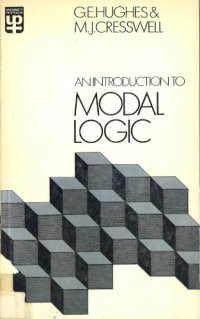
Ebook: An Introduction to Modal Logic
Author: G. E. Hughes M. J. Cresswell
- Genre: Mathematics // Logic
- Series: University Paperbacks Volume 431
- Year: 1972
- Publisher: Methuen
- Language: English
- djvu
Note: This book was later replaced by "A New Introduction to Modal Logic" (1996).
Modal logic can be described briefly as the logic of necessity and possibility, of 'must be' and 'may be'.
We had two main aims in writing this book. One was to explain in detail what modal logic is and how to do it; the other was to give a picture of the whole subject at the present stage of its development. The first of these aims dominates Part I, and to a lesser extent Part II; the second dominates Part III. Part I could be used on its own as a text-book for an introductory course of instruction on the basic theory and techniques of modal logic.
We have tried to make the book self-contained by including at the appropriate points summaries of all the non-modal logic we use in the exposition of the modal systems. It could therefore be tackled by someone who had not studied any logic at all before. To get the most out of it, however, such a reader would be well advised to buy himself another book on logic as well and to learn something more about the Propositional Calculus and the Lower Predicate Calculus than we have been able to tell him here.
Modal logic can be described briefly as the logic of necessity and possibility, of 'must be' and 'may be'. We had two main aims in writing this book. One was to explain in detail what modal logic is and how to do it; the other was to give a picture of the whole subject at the present stage of its development. The first of these aims dominates Part I, and to a lesser extent Part II; the second dominates Part III. Part I could be used on its own as a text-book for an introductory course of instruction on the basic theory and techniques of modal logic. We have tried to make the book self-contained by including at the appropriate points summaries of all the non-modal logic we use in the exposition of the modal systems. It could therefore be tackled by someone who had not studied any logic at all before. To get the most out of it, however, such a reader would be well advised to buy himself another book on logic as well and to learn something more about the Propositional Calculus and the Lower Predicate Calculus than we have been able to tell him here.
Modal logic can be described briefly as the logic of necessity and possibility, of 'must be' and 'may be'. We had two main aims in writing this book. One was to explain in detail what modal logic is and how to do it; the other was to give a picture of the whole subject at the present stage of its development. The first of these aims dominates Part I, and to a lesser extent Part II; the second dominates Part III. Part I could be used on its own as a text-book for an introductory course of instruction on the basic theory and techniques of modal logic. We have tried to make the book self-contained by including at the appropriate points summaries of all the non-modal logic we use in the exposition of the modal systems. It could therefore be tackled by someone who had not studied any logic at all before. To get the most out of it, however, such a reader would be well advised to buy himself another book on logic as well and to learn something more about the Propositional Calculus and the Lower Predicate Calculus than we have been able to tell him here.
Download the book An Introduction to Modal Logic for free or read online
Continue reading on any device:

Last viewed books
Related books
{related-news}
Comments (0)